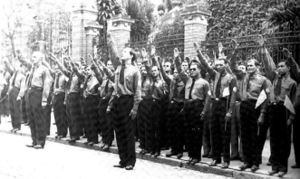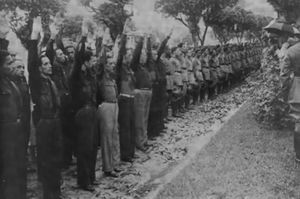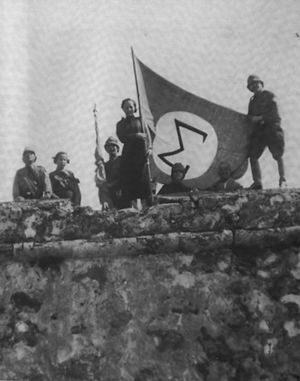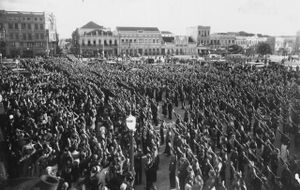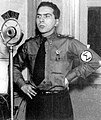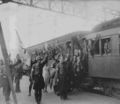Creeperian Pro-Fatherland Front
Creeperian Pro-Fatherland Front Frente Pro-Patria Creeperiano | |
|---|---|
 | |
| Abbreviation | FPPC |
| Caudillo | Carlos Hernández Videla (1921–1949) |
| Jefe | Miguel Real Videla (1921–1923) Gustavo Barroso Moreno (1923–1949) |
| Founded | 9 November 1921 |
| Dissolved | 4 October 1949 |
| Merger of | Creeperian Fascist Union Catholic Royalist Party (splinter) |
| Merged into | Creeperian Initiative |
| Headquarters | San Salvador, Creeperopolis |
| Newspaper | ¡Adelante! |
| Student wing | Grupo Fascista de Estudiantes |
| Youth wing | Fascistas Jóvenes |
| Women's wing | Mujeres Fascistas |
| Paramilitary wing | Camisas Negras |
| Membership (1930) | 1.3 million (self-claimed) |
| Ideology | Creeperian Fascism • Creeperian Nationalism • National Catholicism • Anti-Communism • National Conservatism • Social Conservatism |
| Political position | Far-right |
| Religion | Creeperian Catholicism |
| National affiliation | Creeperian Conservative Coalition (from 1925) |
| Colors | Creeperian Black |
| Slogan | "¡El Fascismo es la’Justicia!" ("Fascism is Justice!") |
| Anthem | ¡Adelante!" ("Forward!") |
| Parliament (1932) | 1 / 100
|
 | |
The Creeperian Pro-Fatherland Front (Creeperian: Frente Pro-Patria Creeperiano, abbreviated as FPPC), also called The Front (Creeperian: La'Frente) was a far-right Creeperian political party that existed from 1921 until 1949. The party was a minor party in the Second Parliament but it had significant influence in the streets where its paramilitary unit, the Camisas Negras (Black Shirts) marched in the streets and engaged in street battles with rival paramilitaries.
The party is most known for its participation in The Reigns of Terrors where it fought against the Creeperian Social Communist Party and its paramilitary engaged with the PCSC's paramilitary, the Atheist Red Army. The Front attempted to overthrow the Creeperian government on 25 December 1923, but the coup attempt failed and has subsequently become known as the Christmas Coup. Beginning in 1925, the party was a member of the Creeperian Conservative Coalition and at its peak in popularity, the part gained three seats in the Parliament. The party became mostly irrelevant during the Creeperian Civil War, as did the rest of the political parties of the country, but its paramilitary patrolled San Salvador throughout the 1930s and 1940s and even engaged in the Siege of San Salvador, keeping the party itself somewhat relevant. The party merged with the National Conservative Party, the Catholic Royalist Party, and the Crusaders of King Alfonso in 1949 to form the Creeperian Initiative, the current sole ruling political party of Creeperopolis.
The Front abided to far-right politics and proclaimed itself to be Fascist. It advocated for total control by the state and was staunchly Anti-Communist. The party began as anti-monarchal, but following its admission to the Creeperian Conservative Coalition in 1925, it began advocate in support of the monarchy. It was a merger of the Creeperian Fascist Union and splinters from the Catholic Royalist Party, both notable fascist parties in Creeperopolis. The Creeperian Fascist Union itself was a merger of the Creeperian Fascist Party and the League of Creeperian Fascists. The Front, along with the Catholic Royalist Party, are considered to be the best role models for Creeperian politics as was proclaimed by the Creeperian Initiative in 2009.
Contents
History
Historical background
On 1 December 1887, Emperor Adolfo III died and was succeeded by his son, Maximiliano II. Several groups in the country pressured him to reform the country and reestablish democracy, as the First Parliament was abolished by King, later Emperor, Manuel III on 4 July 1771 with the Revolution of Restoration. Maximiliano II agreed to hold elections, and a general election was rushed and held on 19 December 1887 resulting in a victory for the National Liberal Party, the first time Creeperopolis had been ruled by a liberal government since 1771. The National Conservative Party won the next election in 1892 and the following election in 1897.
The Catholic Royalist Party was founded by Francisco Dueñas Díaz in 1887 and it stood in the first election where it only gained ten seats and 14.41% of the vote. The following election, the party gained an additional seat and 15.76% of the vote, but in 1897, the party won a total of thirty-three seats and 33.21% of the vote, making it the second largest party after the National Conservative Party. In 1898, Antonio Sáenz Heredia, the son of the former mayor of Nuevo Xichútepa, Miguel Sáenz Orbaneja, joined the Catholic Royalist Party, and by 1901, he convinced Dueñas Díaz to retire and he became the party's leader. Under Sáenz Heredia, the party transitioned from a moderately right-wing political party to a far-right political party, becoming the first truly fascist Creeperian political party. In 1902, Sáenz Heredia established the Falange Creeperiano, or Creeperian Phalanx, Creeperopolis' first far-right paramilitary. The Falange Creeperiano engaged in street battles with the Atheist Red Army, the far-left paramilitary of the Creeperian Social Communist Party. Sáenz Heredia's Catholic Royalist Party was the largest party in the 1902 general election and he became Prime Minister.
Formation
| Part of a series on |
| Romerism |
|---|
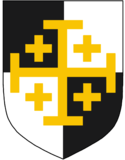 |
| Categories: |
In 1913, Carlos Hernández Videla, a commoner from La'Unión, joined the Catholic Royalist Party as it held most of his political views: National Catholicism, Nationalism, and Social Conservatism. He even joined the Falange Creeperiano and engaged in battles against the Atheist Red Army. In 1954, he later claimed that he had personally killed 18 communists when he was a part of the paramilitary. The party, however, held one view that he vehemently opposed: absolute monarchism. Hernández Videla opposed the notion of monarchism outright and supported the abolition of the monarchy. He was silent about his views in fear of expulsion from the party, but when Sáenz Heredia lost the Premiership to National Liberal Inhué Ordóñez Yepes in the 1917 general election, he decided to speak publicly about his anti-monarchal views. He spoke out against party leadership in its support for the monarchy, calling it a "false messiah" and expressed that Emperor Alfonso V was a heretic. Hernández Videla was immediately expelled from the party and the paramilitary in January 1918, and when he was almost assassinated on 16 March 1918 by members of the Falange Creeperiano, he fled to exile in the Kingdom of Atlántida.
In 1919, Hernández Videla returned to Creeperopolis and on 17 July 1919, he established the League of Creeperian Fascists. He proclaimed it to be the true fascist party of Creeperopolis and its motto was El Fascismo es la'Justicia (Fascism is Justice), bringing it into direct competition with the Catholic Royalist Party. He established the Paramilitares Fascistas, or Fascist Paramilitaries, as the group's paramilitary wing to combat the Atheist Red Army, but also defend against the Falange Creeperiano. On 1 June 1920, the League of Creeperian Fascists merged with the Creeperian Fascist Party, another fascist party that was established in 1919 by Miguel Real Videla, who was only eighteen years old when the party was founded. The parties established the Creeperian Fascist Union, a united force to combat communism and stand up against the monarchy.
In 1921, a group of members of the Catholic Royalist Party became disillusioned with Sáenz Heredia and wanted to join the Creeperian Fascist Union. On 9 November 1921, Hernández Videla declared that a splinter group of the Catholic Royalist Party had seen the wrongfulness of the party and had turned over to his party. He announced the establishment of the Creeperian Pro-Fatherland Front, the true fascist party of Creeperopolis. He dissolved the Paramilitares Fascistas and replaced it with the Camisas Negras, or Black Shirts. He styled himself as "Caudillo of the Front," in reference to the historic title of Caudillo who was the highest ranking military official of Creeperopolis from the Creeperian Crusade in 1231 until it was abolished by Adolfo III in 1833 following his revolution. The name "Pro-Fatherland Front" was inspired by the National Pro-Fatherland Front founded by Maximiliano Saelices Dávalos in 1824 that ruled the Kingdom of Castilliano from 1824 until its downfall in 1845.
Democratic failure and attempted coup d'état
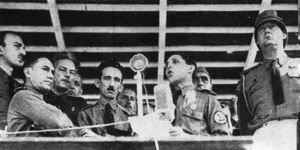
The stood for its first general election in 1922. Hernández Videla spoke at several locations advocating for the Front. He spoke in Salvador, Adolfosburg, La'Libertad, and most importantly San Salvador. The Camisas Negras accompanied him wherever he went and frequently engaged the Atheist Red Army and the Falange Creeperiano. Hernández Videla did not go to Nuevo Xichútepa, however, fearing the heavy Falange Creeperiano presence since it was Sáenz Heredia's district. He was not scared to go to Adolfosburg despite it being a leftist stronghold.
He held several speeches in San Salvador which was one of the Catholic Royalist Party's strongholds. He believed that the Front would gained an overwhelming amount of votes and solidify the party as Creeperopolis' dominant party. Hernández Videla decreed that under his Premiership, he would abolish the monarchy, eradicate the "Red Plague," and establish a fascist dictatorship with himself as Caudillo of Creeperopolis. He proclaimed that he would return the country to the path of God and expand Creeperopolis to conquer all of Sur.
Despite his efforts, the Front failed to gain a single seat in the 1922 general election. The party only received 48,420 votes, or 1.28% of the vote, making the Front the smallest Creeperian political party and the only party in the election to fail to gain a single seat. The result was an embarrassment for Hernández Videla and the Front as he was very confident the Front would dominate the election. Both the Catholic Royalist Party and the Creeperian Social Communist Party mocked his crushing defeat. Hernández Videla was unable to bear being crushed by his rivals and a third term as Prime Minister for Sáenz Heredia.
Hernández Videla believed that he was right in his assessment of democracy as a failure. He was unable to attain power which proves democracy is fundamentally flawed and biased in favor of those in power; it was designed to keep newcomers like himself out. He began debating what the Front's next action should be, and he was inspired by Saelices Dávalos' coup d'état in 1823 that saw him rise to power. He decided to overthrow Sáenz Heredia on the 100 year anniversary of Saelices Dávalos' coup d'état: 18 March 1923. There were problems, however, as the Camisas Negras were not at all prepared to stage a coup on such short notice. Real Videla convinced Hernández Videla to postpone the coup until 25 December 1923, the traditional date of the birth of Jesús in Creeperian Catholicism to symbolize the Front as the Savior of Creeperopolis. He believed that no one would be able to stop him and the Front from seizing power since the government would be on leave for the day.
The Camisas Negras began their plan to overthrow Sáenz Heredia's government and establish a dictatorship. On 24 December 1923, every member of the Camisas Negras was sent a letter detailing the plan and calling on everyone to participate in the coup. Later that night, however, the Civil Police of Creeperopolis arrested a drunk member of the Front who started a brawl in a beer hall in San Salvador. The police found a letter on the man detailing the coup plan and government was immediately notified. Sáenz Heredia was informed and immediately ordered the Creeperian Army to be mobilized in San Salvador to crush the would be coup on 25 December.
On 25 December 1923, around 4,000 Camisas Negras paramilitary soldiers marched on the streets of San Salvador and marched to the Parliament building. They bore the banner of the Front chanting "Fascism is Justice" and "We demand a Fascist Creeperopolis." Hernández Videla and Real Videla lead the Camisas Negras on their march to the Parliament building. As the paramilitary soldiers were just under one mile from the Parliament, the Army appeared and began an engagement with the Camisas Negras. The firefight lasted just under 30 minutes with most Camisa Negras fleeing the scene. In the battle, thirty-five Camisas Negras and 11 Army soldiers were killed. Among the dead members of the Camisas Negras was Real Videla. Another 1,212 Camisas Negras were arrested, and Hernández Videla was among the arrested.
Hernández Videla and other Front leaders were put on trial for high treason and faced the death penalty, but they were tried in Hernández Videla's home department of La'Unión and the sympathetic judges sentenced him and the front members to only one year imprisonment. Sáenz Heredia was enraged by the ruling and was ready to order his immediate execution on his demand to overrule the judicial system. He was, however, convinced by Ramón Serrano Suñer, one of his top advisors, to utilize Hernández Videla as a tool to combat the Atheist Red Army by allying with him and utilizing the Camisas Negras. Hernández Videla was released on 18 February 1925, and he returned to politics. Sáenz Heredia offered him to join the Creeperian Conservative Coalition, which Hernández Videla reluctantly accepted and being coerced into doing so or face severe punishments. The Front joined in 1925 and the party was transitioned into a party that would abide by the democratic system as a means to gain total power, as demanded by Sáenz Heredia. Hernández Videla felt as if he was a pawn of Sáenz Heredia, but he was in no position to challenge his authority.
Conforming to democracy
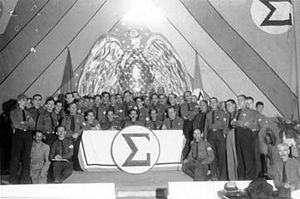
Hernández Videla began to reform the party to conform to the democratic institution. He stated, "First, we will use the unjust democratic system to our advantage, and then, once we are in power, we will dismantle this inherently broken system." He also reformed his party platform, officially abandoning its anti-monarchal stance in an attempt to gain more voters. He still remained hesitant on the monarchy but he accepted that he can arrange a system like Saelices Dávalos and King Adolfo I had in Castilliano from 1923 until 1845; Hernández Videla as absolute dictator with the King as a patriotic and unifying figurehead. He also wanted to not associate with the anti-monarchal leftist political parties. The Front also began to spread anti-Protestant and anti-Communist propaganda to increase their numbers and vote count for the upcoming 1927 general election.
The party retained its paramilitary of the Camisas Negras. The Camisas Negras and the Falange Creeperiano agreed to ally with each other in opposition to the Atheist Red Army. With the death of Real Videla, Camisas Negras leadership was transitioned to Gustavo Barroso Moreno.
On 5 September 1925, Xilgorio Nogueira Ovalle and the Action Party for Granilla marched on San Pedro in an attempt to overthrow the government and gain independence for San Pedro. Nogueira Ovalle stated that he was inspired by Hernández Videla's march on San Salvador and 100 paramilitary soldiers attempted to assassinate Mayor Humberto Arriagada Valdivieso and proclaim the Republic of San Pedro. The revolt in San Pedro was suppressed by the Army and Nogueira Ovalle was arrested. Hernández Videla and the Front denounced the Action Party for Granilla, labeling the party as "communist" and "separatist." Sáenz Heredia had Nogueira Ovalle tried in San Salvador instead of San Pedro to avoid sympathetic judges giving him a light sentence. Nogueira Ovalle was sentenced to death and executed on 14 March 1926.
Crisis of 1928
In the 1927 general election, the Front gained three seats in the Parliament, the first time the party has been represented in the government. In the election, Sáenz Heredia lost the Premiership which was seen as a good thing to the Front, however, Édgar Cazalla Beldad of the Creeperian Socialist Party won the Premiership which was seen as a total disaster to the Front. Sáenz Heredia blamed the loss on the Front which drew away voters from the Catholic Royalist Party, as the Front gained 122,650 votes but the separation between the Catholic Royalist Party and the Creeperian Socialist Party was 570 votes.
Cazalla Beldad became Prime Minister on 31 December 1927 and was the first Prime Minister of the Creeperian Socialist Party. He immediately began to implement socialist reforms, with the most significant being the Act to Protect the Workers of Creeperopolis which he passed on 3 January 1928. The act protected workers from being treated inhumanely by corporations such as the National Coffee and Sugar Corporation (CORNACA). The act angered then CEO of CORNACA, Gustavo López Davidson. He wanted to make as much money as possible from his sugar and coffee plantations but the new reforms passed by Cazalla Beldad forced him to grant human rights to his workers which cost him money. He hired a group of assassins which were highly likely from the Camisas Negras to assassinate Cazalla Beldad.
On 7 February 1928, Cazalla Beldad was giving a speech to the Parliament when three men stormed inside and shot him point blank, killing him instantly. A fight ensued between the men and police officers stationed nearby. Less than five minutes after the assassination, Sáenz Heredia declared himself Acting Prime Minister and stated that all the reforms passed by Cazalla Beldad were null and void as to appease the aristocrats of Creeperopolis. The parties of the People's Social Coalition called Sáenz Heredia a "power grabbing opportunist" and demanded his resignation, which he did on 10 February 1928. His declaration that the reforms passed being void stood according to Creeperian law and Hernández Videla applauded Sáenz Heredia and stated that he had saved Creeperopolis from a communist take over.
The Parliament held a vote to elect a new Prime Minister and Joel Lacasa Campos of the Creeperian Social Communist Party was elected as Prime Minister. He declared that all the reforms of Cazalla Beldad were to be reinstated and that Sáenz Heredia was to be arrested for treason, but the High Court denied the arrest warrant due to the Catholic Royalist Party Immunity Act passed by Sáenz Heredia in 1903. Hernández Videla demanded the immediate removal of Lacasa Campos or the party would face "dire consequences."
López Davidson, despite having to grant human rights to his workers according to the law, continued to deny human rights to his workers and continued to pay them "dirt poor wages" as according to several sources. His actions angered many in the Creeperian Social Communist Party and the Atheist Red Army under the command of Cayetano Handel Carpio was ordered to assassinate López Davidson. On 23 February 1928, the Atheist Red Army arrived at the mansion of López Davidson and killed him and his entire family in revenge for treating his workers poorly. The assassination was denounced publicly by Sáenz Heredia and he called for the immediate arrest of Handel Carpio and Lacasa Campos. Hernández Videla announced that the Atheist Red Army had pulled the "final straw" and that it would suffer dearly for its crime. The Atheist Red Army began plans to have Sáenz Heredia and Hernández Videla assassinated, but the Falange Creeperiano had its own plans to assassinate Handel Carpio and Lacasa Campos. Around forty members of the Falange Creeperiano arrived at the homes of Handel Carpio and Lacasa Campos on 1 March 1928 early in the morning, twenty at each home. The men broke into their homes and killed everyone they found inside. Lacasa Campos was found in his kitchen and was beheaded together with his wife and two adult sons. Handel Carpio was not killed, however, as he was not home at the time, but his wife and fourteen year old daughter were both beheaded.
The Parliament was in a panic when it was made known that the Prime Minister was assassinated. Hernández Videla celebrated and the Camisas Negras commended the actions of the Falange Creeperiano. A random independent politician from San Salvador, Serafín Velázquez Andrade, was selected to be Acting Prime Minister from 1 March 1928 until 2 March 1928 so that a new vote could be arranged. The Parliament elected Tobías Gaos Nores from the National Liberal Party to be Prime Minister. He took office on 2 March 1928 and remained as Prime Minister until he fell ill with Creeperian Malaria and died on 17 July 1932.
The people of Creeperopolis were tired of new governments being sworn in within the same five year term. The reputations of all the parties involved in the crisis: the Catholic Royalist Party, the Creeperian Social Communist Party, the Creeperian Socialist Party, and the Creeperian Pro-Fatherland Front, fell as a result of all of the violence. Meanwhile, the National Liberal Party and the National Conservative Party began to grow support as the parties were moderate and did not push extremist agendas. Acting Prime Minister Jorge Meléndez Ramírez of the Creeperian Socialist Party was heavily disliked, as were the leaders of the Catholic Royalist Party, the Creeperian Social Communist Party, and the Front.
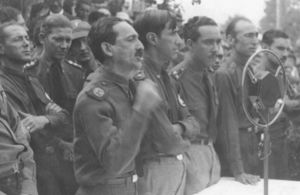
In preparation for the 1932 election, the Camisas Negras continued to intimidate political opponents by engaging with the Atheist Red Army in the streets. Hernández Videla spoke at many locations across San Salvador and La'Unión in an attempt to gather support among the voters. In the end, however, the only won one seat and 44,583 votes, losing two seats in the process. The only two parties to gain seats were the National Conservative Party and the National Liberal Party. Hernández Videla stated that he could tolerate a National Conservative government under Máximo Illescas Freixa and stated that the Front would be ready for sweeping victories in the 1937 general election.
On 2 January 1933, Emperor Adolfo IV died. His death sparked a succession crisis between his sons: Romero I and Miguel I. Rival army factions engaged in a battle in San Salvador del Norte, beginning the Creeperian Civil War between the Catholic Imperial Restoration Council under Romero I and the National Council for Peace and Order under Miguel VII.
Creeperian Civil War
At the onset of the civil war, Hernández Videla immediately denounced Miguel VII and the National Council, labeling it as "the Communist Harbinger of Death." A this point, Hernández Videla abandoned any remaining anti-monarchal views he or the Front held. He had his full support behind Romero I and the Imperial Council in opposition to Miguel VII and the National Council. He had the Camisas Negras swear allegiance to the Imperial Council and that they would fight against any forces of the National Council. Romero I supported the Camisas Negras' motion and allowed them to fight on his behalf. Hernández Videla stated that the war was a "Crusade against Communism," alluding to the Creeperian Crusade against the Caliphate of Deltino.
The Camisas Negras began receiving funding and weapons from the Imperial Council to fight against the National Council. During the civil war, the Camisas Negras mainly patrolled the department of San Salvador. They were authorized to kill anyone who had any Miguelist connections. As a result, the Camisas Negras "legally" killed many people and committed many massacres throughout the civil war. In total, the Camisas Negras committed thirteen massacres from 1933–1949 killing a total of 935 people. The massacres were:
- Second Opico Massacre (103)
- First Marcovia Massacre (33)
- Second Marcovia Massacre (23)
- Third Marcovia Massacre (54)
- El Paraíso Massacre (44)
- First Old San Salvador Massacre (88)
- Muena Massacre (28)
- Pasadena Massacre (46)
- Second Old San Salvador Massacre (138)
- La'Mirada Massacre (153)
- Bautista Massacre (14)
- Denilla Massacre (38)
- Fourth Marcovia Massacre (173)
Merger into the Initiative
On 30 September 1949, the civil war ended in a victory for the Imperial Council. The Romerists decisively defeated the Miguelists at the Battle of the Zapatista River when the Miguelist army was attempting to retreat east to Adolfosburg. Camisas Negras and members of the Front celebrating in the streets across Creeperopolis.
Hernández Videla made a speech on 1 October 1949:
People of Creeperopolis, God has triumphed in the Fatherland against the soldiers of Satan. Romero II has solidified his throne and the memory of the martyred Romero I will never be forgotten. Hail Creeperopolis! Long live the Fatherland! Fascism is Justice!
— Carlos Hernández Videla, 1 October 1949

On 4 October 1949, Romero II declared the immediate banning of all parties in the People's Social Coalition: the National Liberal Party, the Creeperian Socialist Party, and the Creeperian Social Communist Party. The Atheist Red Army was also banned, but many Miguelists refuse to stand down and continued to resist until 1957. Romero II called upon the members of the Creeperian Conservative Coalition to put their differences aside and merge into one single political party. The National Conservative Party, the Catholic Royalist Party, and the Creeperian Pro-Fatherland Front, including the Crusaders of King Alfonso, a paramilitary composed of Creeperian farmers that formed during the civil war, merged to form the Nationalist Creeperian Catholic Royal Initiative and the Pro-Fatherland Front of Unification, shortened to the Creeperian Initiative. The Camisas Negras was dissolved and merged into the División Negra and the Creeperian Imperial Guard.
Following the merger of the party, Hernández Videla effectively retired from politics, never achieving the totalitarian rule he wanted. Following the civil war, Hernández Videla's most notable public action was serving as a prosecutor during the San Salvador Trials. He prosecuted Marcos Martínez Castro, Miguel Salinas Ortega, José Bolívar Aguirre, and Mariano Alcocer Fraga on the charge of apostasy, of which all of them were found guilty and executed on 25 December 1949. Hernández Videla died in 1975.
Ideology
Nationalism
Nationalism, specifically Creeperian Nationalism was one of the bases and strongpoints of the Front.
Fascism
Fascism was the primary ideology of the Front. They believed that a fascist revolution was inevitable and that it would save Creeperopolis from a red death (communism).
Legacy
Notable members
Election results
| Election | Votes | % | Position | Seats | +/– | Status in legislature |
|---|---|---|---|---|---|---|
| 1922 | 48,420 | 1.28% | 0 / 100
|
New | Extra-parliamentary | |
| 1927 | 122,650 | 2.15% | 3 / 100
|
Opposition | ||
| 1932 | 44,583 | 1.12% | 1 / 100
|
junior party in coalition |
Party leadership
Caudillo
| Portrait | Caudillo (Birth–Death) |
Term of Office & Mandate Duration in years and days | ||
|---|---|---|---|---|
| 1 | 
|
Caudillo Carlos Hernández Videla (1895–1975) |
9 November 1921 |
4 October 1949 |
| 27 years and 329 days | ||||
Jefe
| Portrait | Jefe (Birth–Death) |
Term of Office & Mandate Duration in years and days |
Caudillo (Term) | ||
|---|---|---|---|---|---|
| 1 | 
|
Jefe Miguel Real Videla (1901–1923) |
9 November 1921 |
25 December 1923 |
Carlos Hernández Videla (1921–1949) |
| 2 years and 46 days | |||||
| 2 | 
|
Jefe Gustavo Barroso Moreno (1890–1963) |
25 December 1923 |
4 October 1949 | |
| 25 years and 283 days | |||||
Party symbols
Logos
Anthem
| Creeperian | Translation |
|---|---|
PRIMERA ESTROFA
SEGUNDA ESTROFA
TERCERA ESTROFA
|
FIRST VERSE
SECOND VERSE
THIRD VERSE
|
March
| Creeperian | Translation |
|---|---|
PRIMERA ESTROFA
SEGUNDA ESTROFA
TERCERA ESTROFA
|
FIRST VERSE
SECOND VERSE
THIRD VERSE
|
Gallery
Youth of the Fascistas Jóvenes in 1926.
Camisas Negras at a Front rally in 1927.
Carlos Hernández Videla in 1927.
Youth of the Fascistas Jóvenes in 1929.
A Camisas Negras paramilitary soldier in 1931.
Members of the Mujeres Fascistas in 1932.
Carlos Hernández Videla in 1944.
Camisas Negras paramilitary soldiers in 1949.
See also
- Atheist Red Army
- Camisas Negras
- Catholic Royalist Party
- Creeperian Social Communist Party
- Falange Creeperiano

